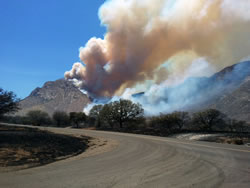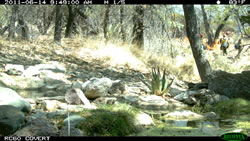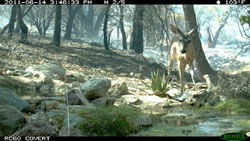National Cohesive Wildland Fire Management Strategy Success Story
Fuels Reduction Minimizes Monument Fire Impacts
Coronado National Memorial, Arizona
Cohesive Strategy - Fire-Adapted Human Communities
2011

Monument Fire along Montezuma ridge (NPS photo / A. Ruiz).

The wildlife camera behind the visitor center picks up the first image of fire with firefighters in the distance.

The flames closer, yet a safe distance from the visitor center.

Deer drinking from the pond behind the Visitor Center soon after the fire passed.
On June 12, 2011, at approximately 1:15 pm, the human-caused Monument Fire started rapidly burning through the grasslands within the Coronado National Memorial. The fire continued to burn through the park and beyond, eventually burning 30,526 acres within the Huachuca Mountains. Nearly 100% of the park's acreage was burned. Some areas burned intensely, but most areas burned with low to moderate severity. Because of the monsoon rains, by the end of August most of the memorial was very green with new growth of grasses, wildflowers, and shrubs.
To help protect buildings during the fire, crews cleared brush and fallen leaves from around the buildings and removed lower limbs of trees. Burnout operations were also utilized to decrease the potential of intense fire in the memorial and to protect the visitor center. These fires were set during times when the humidity was higher and the winds and temperatures lower. The burnout fires burned grasses, while many of the larger shrubs and trees survived in those areas. No park structures were lost. To view podcasts about the Monument Fire as well as footage of the burnout operation behind the visitor center captured by the park’s wildlife camera, visit the Coronado National Park Multimedia web page.
Mechanical fuels reduction and prescribed fire projects conducted over the past few years made it easier to plan and implement burnout operations to protect park structures during the Monument Fire. Recent projects included two prescribed fires in 2009. An eleven-acre prescribed fire was conducted to reduce fuels around park headquarters, park housing, the visitor center and the picnic area; and a 30-acre prescribed burn was done to reduce fuels near the private homes near the memorial’s entrance.
The adjacent Coronado National Forest, Sierra Vista Ranger District, previously conducted a prescribed burn in March 2008 that included a portion of the park. Firefighters also used chainsaws to thin around park structures over the past few years, most recently in 2010, further helping to create defensible space.
The widespread loss of vegetation because of the Monument Fire increased the possibility of flooding and mudslides. The park implemented post-fire rehabilitation efforts to minimize these impacts. Drainages have been cleared of downed trees and other debris, and culverts have been cleaned. This is an on-going project and will be repeated after every significant rain event.
On July 7, 2011, 0.54 inches of rain caused several washes in the park to flow, depositing about six inches of sediment over Forest Road 61, Montezuma Pass Road, at one of the low water crossings. Trail damage included the loss of water bars used for erosion control as well as downed trees. The roads and trails are open to the public now that they have been repaired and known hazards removed.
Contact
Denise Shultz, Chief of Interpretation
Email: Denise_M_Shultz@nps.gov
Phone: (520) 824-3560 x 307